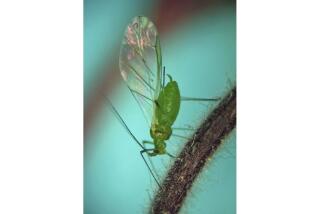Armyworms Invade Northeast
- Share via
NORTH MARSHFIELD, Mass. — The worms crawl in, the worms crawl out.
One day not long ago, Michelle Bracken got a frantic call from her husband. Something is eating our lawn! She rushed home to this suburb south of Boston, where an eerie sight awaited her.
“We literally saw the grass moving,” she recalled.
Three days later, the lush green carpet that to Jim Bracken symbolized the pride of homeownership disappeared.
Munch, munch, munch.
Battalions of armyworms traveled north this year, invading New England’s lawns and golf courses. The voracious demons apparently benefited from a freak streak of spring weather that brought steamy temperatures, a six-week mini-drought and then unseasonable cold to much of the East.
Scientists are studying the incursion by creatures that technically are caterpillars. Entomologists say the armyworm, a.k.a. Pseudaletia unipuncta, feeds on plants belonging to the grass family and causes temporary damage above ground, eating blades and upper parts of stems. The beasts are well known in the South but normally cannot survive past the egg or larva stage in chilly New England.
Tell that to Michelle Bracken: “We looked down, and in a 4-by-4-inch square, there must have been at least 50 of them, little black wormy things. They were disgusting.”
Bracken’s account echoes an 18th century description of “Multitudes of a Kind of Brownish Streaked Worm, as have been very distructive [sic] to the Fruits of the Earth.” The way the worms squirm, they also have been compared to Medusa’s hair.
Chomp, chomp, chomp.
Georgia experienced a serious infestation in March. Six weeks later, the worms attacked North Carolina and next, Delaware. Researchers say heavy thunderstorms that brought rain to New England also carried the immature worms.
As they matured into adult caterpillars, they took up their mission with a vengeance. Starting in midsummer, lawns in New England literally vanished overnight. One town in Vermont, St. Johnsbury, was so badly hit that residents called a community meeting to assess the damage.
On Cape Cod, one lawn maintenance firm fielded 250 calls a day from hysterical homeowners. Some pragmatic Yankees were seen beating their lawns with shovels.
A further frustration was the worms’ fickle nature. While Jim and Michelle Bracken’s lawn was decimated, their neighbors’ yards went untouched. A lawn doctor told the Brackens it was the work of the wind: The worms simply went to work wherever they woke up.
Crunch, crunch, crunch.
The good news is that the damage is not permanent. Unlike root-hungry grubs, the worms eat only grass blades. Some landscapers use pesticides to eradicate the worms quickly. Researchers say once they are through feeding, some of the worms spin cocoons from which they emerge as moths. Others, for unknown reasons, give up and die.
Left behind are revolting little insect bodies that crunch underfoot. On roads and driveways, their carcasses bleed green. Sanding is the only way to get rid of the residue.
With proper irrigation, most lawns recover fully within a few weeks. The Brackens’ front yard already has begun to return to its verdant state.
At the moment, the armyworms appear to be on hiatus in New England.
But with an egg-to-moth life cycle of 30 to 40 days, the next generation of hungry caterpillars could arrive before summer’s end.
“I hate bugs,” Michelle Bracken said.
More to Read
Sign up for Essential California
The most important California stories and recommendations in your inbox every morning.
You may occasionally receive promotional content from the Los Angeles Times.












